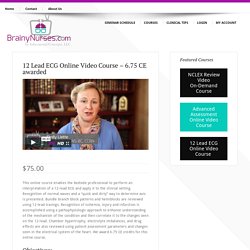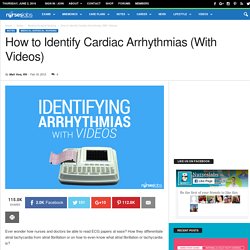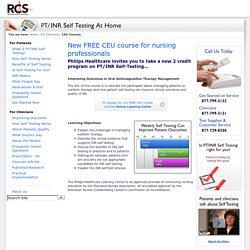

12 Lead ECG Online Video Course – 6.75 CE awarded. This online course enables the bedside professional to perform an interpretation of a 12-lead ECG and apply it to the clinical setting.

Recognition of normal waves and a “quick and dirty” way to determine axis is presented. Bundle branch block patterns and hemiblocks are reviewed using 12-lead tracings. Recognition of ischemia, injury and infarction is accomplished using a pathophysiologic approach to enhance understanding of the mechanism of the condition and then correlate it to the changes seen on the 12-lead. Chamber hypertrophy, electrolyte imbalances, and drug effects are also reviewed using patient assessment parameters and changes seen in the electrical system of the heart. We award 6.75 CE credits for this online course. What's the color of your pee? Even artichokes have hearts. : Photo. Laboratory Values and Interpretation - A Nurse's Ultimate Guide.
Laboratory values provide healthcare professionals with essential clues about the patient’s condition and the medical interventions needed for his full recovery.

As nurses are the first-line responders to the healthcare needs of patients, we should always be familiar with the common laboratory values and how to interpret them. Also Read: Nursing Mnemonics and Tricks for Nurses (Diagnostics) I. Complete Blood Count. Complete blood count is one of the most basic laboratory examinations to determine the status of the patient’s health. A. The red blood cells’ primary function is to carry oxygen in the bloodstream. On the other hand, if the total RBC count is above normal, polycythemia vera may be present. Normal range: Male: 4.5–5.5 x 1012/L Female: 4.0–5.0 x 1012/L Children: 3.8–6.0 x 1012/L Newborn: 4.1–6.1 x 1012/L High Level: Dehydration, cigarette smoking, congenital heart disease, pulmonary fibrosis, renal cell carcinoma, polycythemia vera.
B. Male: 140–174 grams per liter (g/L) VT versus SVT with aberrancy. Advanced Hemodynamics. Icuguidebook. File:Diagram of the human heart (cropped).svg. Cancel Edit Delete Preview revert Text of the note (may include Wiki markup) Could not save your note (edit conflict or other problem).

Please copy the text in the edit box below and insert it manually by editing this page. Upon submitting the note will be published multi-licensed under the terms of the CC-BY-SA-3.0 license and of the GFDL, versions 1.2, 1.3, or any later version. See our terms of use for more details. Save To modify annotations, your browser needs to have the XMLHttpRequest object. [[MediaWiki talk:Gadget-ImageAnnotator.js|Adding image note]]$1 [[MediaWiki talk:Gadget-ImageAnnotator.js|Changing image note]]$1 [[MediaWiki talk:Gadget-ImageAnnotator.js|Removing image note]]$1. How to Study in Nursing School: Format for Nursing Process. Almostadoctor. Welcome to ICU OpenCourseWare. Anatomy & Physiology. Martindale's Nursing Center: Nursing Practice, Cases, Courses, Databases, Lectures, Journals, Videos, etc. Courses & Certificates. Patient Safety PS 100: Introduction to Patient Safety PS 101: Fundamentals of Patient Safety PS 102: Human Factors and Safety PS 103: Teamwork and Communication PS 104: Root Cause and Systems Analysis PS 105: Communicating with Patients after Adverse Events PS 106: Introduction to the Culture of Safety PS 201: Partnering to Heal: Teaming Up Against Healthcare-Associated Infections PS 202: Preventing Pressure Ulcers Improvement Capability.

Nursing student pharm help. How to Identify Cardiac Arrhythmias (With Videos) - Nurseslabs. Ever wonder how nurses and doctors be able to read ECG papers at ease?

How they differentiate atrial tachycardia from atrial fibrillation or on how to even know what atrial fibrillation or tachycardia is? ECG reading takes some serious skill, a keen eye and a good theoretical foundations on the different dysrhythmias and the concepts around heart’s conduction and about the ECG machine itself.
It takes time to develop a skill in interpreting ECGs, but once you get the hang of it, you’ll be able to interpret any squiggly line in the ECG paper. So What’s an ECG? ECG (or sometimes EKG) stands for electrocardiogram which was invented Willem Einthoven wherein during his experimentation, instead of using the usual adhesive leads as we have today, he would immerse each of the patients limb into containers of salt solutions and from there, their ECG was recorded. Sinus Tachycardia Sinus tachycardia is a heart rate greater than 100 beats per minute that originated from the sinus node.
Atrial Flutter. New FREE CEU course for nursing professionals. Improving Outcomes in Oral Anticoagulation Therapy Management The aim of this course is to educate the participant about managing patients on warfarin therapy and how patient self testing can improve clinical outcomes and quality of life.

Learning Objectives Explain the challenges of managing warfarin therapy.Describe the clinical evidence that supports INR self testing.Discuss the benefits of INR self testing to practices and to patients.Distinguish between patients who are and who are not appropriate candidates for INR self testing.Explain the INR self-test process. The Philips Healthcare Learning Center is an approved provider of continuing nursing education by the Maryland Nurses Association, an accredited approver by the American Nurses Credentialing Center's Commission on Accreditation.